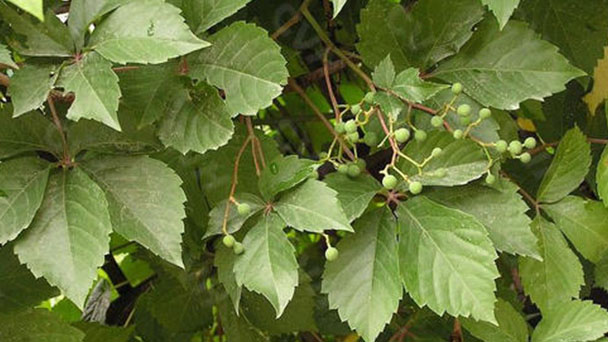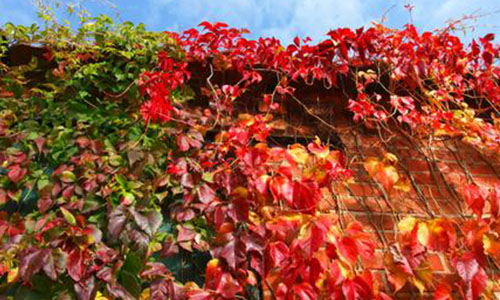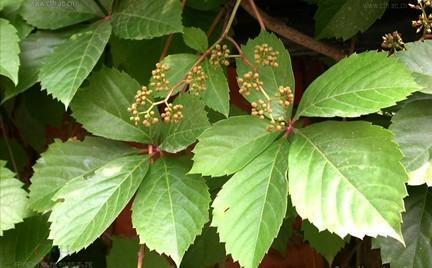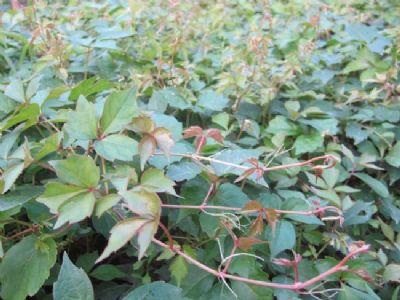Parthenocissus Quinquefolia profile
Written by Maggie
Dec 09 2020

Parthenocissus Quinquefolia is a plant for vertical, stereoscopic, and ground cover applications.It is a kind of parthenocissus that we often see at ordinary times, it is very widespread, in the northeast of China to north China have this strong vitality of plants.Let's take a closer look at it.
Parthenocissus Quinquefolia picture

The form of Parthenocissus Quinquefolia:
Parthenocissus Quinquefolia is a wood rattan.Branchlets are cylindrical, glabrous.Tendrils have 5-9 branched, 2 sectioned apart, discontinuous opposite to leaves, tendrils tapered when tender at apex and expanded into suckers when attached.
For palmate leaves 5 flocculus, lobular ovoid, pour egg elliptic or lateral leaflets elliptic, 5.5-15 cm long, 3 to 9 cm wide, the widest in the upper central or lateral leaflets the widest in nearly.The apex is short tail tip, base cuneate or broadly cuneate.The margin has coarsely serrate. The above color is green, light green below. Both surfaces are glabrous or below veins on micro puberulous;The lateral veins were 5-7 pairs, and the reticular veins were not prominent on both sides.The petiole is 5 -- 14.5 cm, glabrous, leaflets short-stalked or almost sessile.
Inflorescences pseudo terminal forms distinct spindles of paniculate polycymes, 8 -- 20 cm long;The peduncle is 3 -- 5 cm long, glabrous. Parthenocissus Quinquefolia pedicels are 1.5-2.5 mm long, glabrous;The bud is elliptic, 2-3 mm high, apex rounded.It has 5 petals, oblong, 1.7-2.7 mm high, glabrous. Parthenocissus Quinquefolia has 5 stamens, filaments 0.6-0.8 mm, anthers oblong, 1.2-1.8 mm;The disk is not obvious;The ovary is ovoid, tapered to style, or late style slightly reduced at base, stigma not enlarged.
The Parthenocissus Quinquefolia fruit is spherical, 1-1.2 cm in diameter, with 1-4 seeds;Seeds are obovate, apex rounded, base apiculate into a short beak. The seed umbilicus in the middle of the back of the seed is nearly round, the middle ridge of the abdomen is prominent, both sides of the hollow groove, from the seed base up to the seed tip obliquely.Flowering period is June to July, and fruiting period is August to October.
The growth habit and origin of Parthenocissus Quinquefolia:
The Parthenocissus Quinquefolia is light-loving. It is slightly shade tolerant, cold tolerant and well adapted to the soil and climate, but grows better on rich sandy loam. It is cultivated in Northeast, North China. The Parthenocissus Quinquefolia is native to North America.
Cultivation and propagation of Parthenocissus Quinquefolia:
Parthenocissus Quinquefolia is usually propagated by cutting, sowing or laminating.It has strong adaptability and resistance to impoverish and drought.It is hardy (wintering in open fields in northeast China) and heat-resistant (it grows well in Guangdong).
Seeding method:
After the harvested The Parthenocissus Quinquefolia seeds are rubbed to remove the skins and flesh, washed and dried, they can be stored at low temperature in wet sand -- winter. Heat preservation and moisture are conducive to accelerating buds. In the early spring of the next year, seeds can be planted on the ground in the first half of March, covered with film, seedlings can emerge in the first half of May, and the nursery can be cultivated for 1-2 years.

Cuttage:
In early spring, 20-30cm of The Parthenocissus Quinquefolia stem and vine were cut and inserted into the seedling bed on the open ground, irrigated and kept wet. Then, the stems and vines could be quickly pulled out to survive. In summer and autumn, they could also be cut with young branches with leaves, shaded, watered and maintained, and new branches could be quickly taken out.Hardwood cuttings were carried out in March and April. The hardwood cuttings were cut into a section of 10-15cm and inserted into the soil. The cuttings were watered thoroughly and kept moist.Twig cuttings were taken from the current year and carried out in summer.
Layering method:
Wavy layering method can be used in the rainy season wet cloudless weather, with high survival rate, and in autumn it can be separated and transplanted for the next year.
Propagate by cutting, layering and sowing.Cuttage, from deciduous to before germination can be carried out.Seed can be picked in October and sown in winter or spring of the following year.Transplanting or transplanting occurs during the deciduous period.Parthenocissus Quinquefolia is usually propagated by cuttings, and it has been proved that seed propagation is also a good method, with a seedling emergence rate up to 80 {bf} and convenient seedling stage management.
The value of Parthenocissus Quinquefolia:
The fruit of the Parthenocissus Quinquefolia has little kernel and large flesh, and is not edible.
Parthenocissus Quinquefolia is good materials for vertical landscaping, lawn and ground cover walls, verandas, rocks or old tree trunks can also be used as ground cover.
Tendril stem vertical and horizontal, densely covered roots, green leaves all over the screen. After autumn into winter, leaves become red or yellow, very gorgeous.Vertical afforest is one of the main tree species.Suitable for planting house walls, walls, garden entrance, stone side of bridge, etc.
Parthenocissus Quinquefolia has strong resistance to sulfur dioxide and other harmful gases, and it is also suitable to be used as green materials in industrial and mining neighborhoods.Vine stems and roots are used medicinally.

Latest Updated
- Benefits of Bugleweed - 7 Science-backed Health Benefits
- Bugleweed Dangers & Side Effects - Is It Poisonous?
- How to Plant Evergreen Trees - What You Should Know
- When to Plant Evergreens - Grow Guide for Evergreen Trees
- 12 Wonderful Evergreen Shrubs for Your Garden
- 12 Popular Evergreen Plants with Pictures for Beginners
- When And How To Prune A Lilac Bush Like a Pro
- How to Grow & Care for Lilac Vine (Hardenbergia Violacea)
- Japanese Lilac Tree (Syringa Reticulata) Care & Propagation Guide
- Shumard Oak Pros and Cons - What to Know
Popular Articles
- Winter maintenance of Antirrhinum Majus
- How to Grow Terminalia Mantaly Tree
- How to Grow and Care for Crossostephium Chinense
- How to grow Antirrhinum Majus in spring
- Peristeria Elata (Dove Orchid) Profile: Info & Care Guide
- Underwatered Snake Plant (Sansevieria Trifasciata) - Signs And How To Fix
- How to Care for Brazilian Jasmine Plant (Mandevilla Sanderi)
- How to Grow & Care for Graptopetalum Purple Delight in Summer
- Rosa Chinensis (China Rose): Plant Growing & Care Tips
- How to Care for Baby Sun Rose (Aptenia Cordifolia)